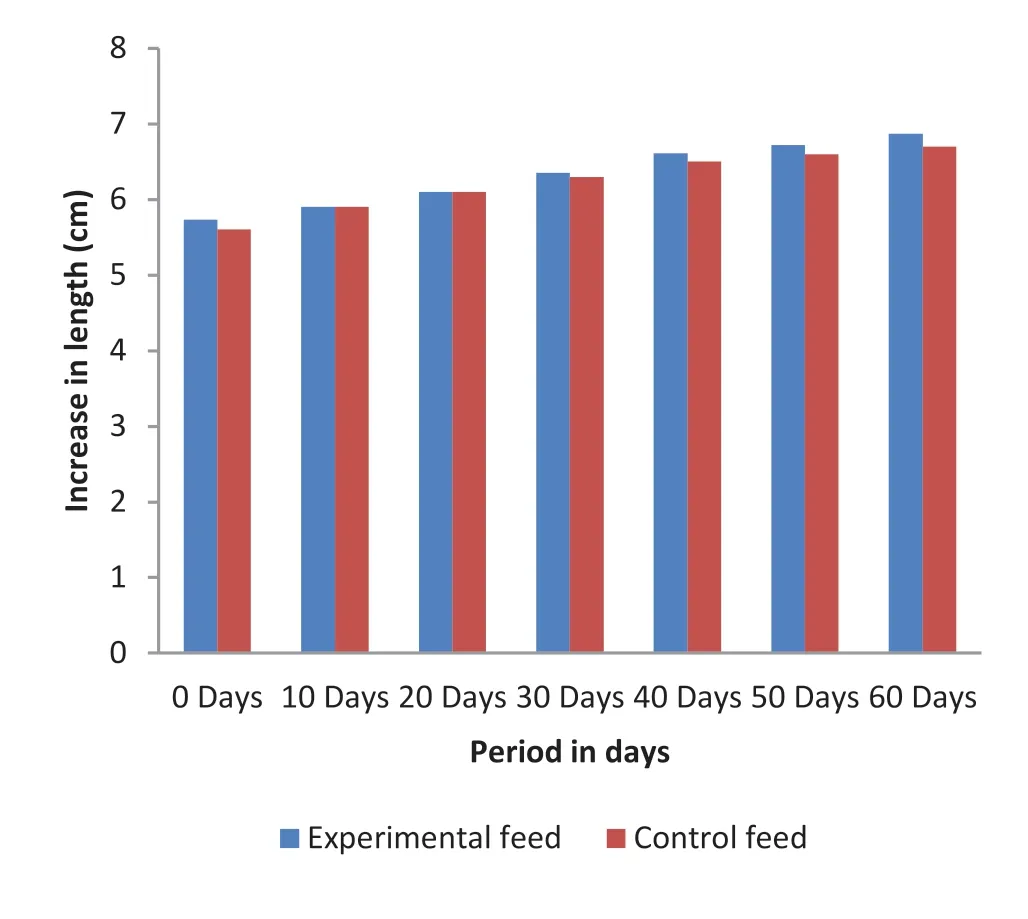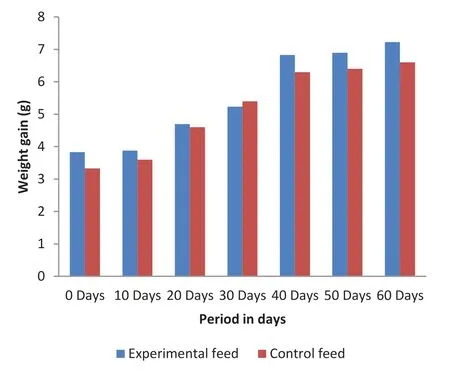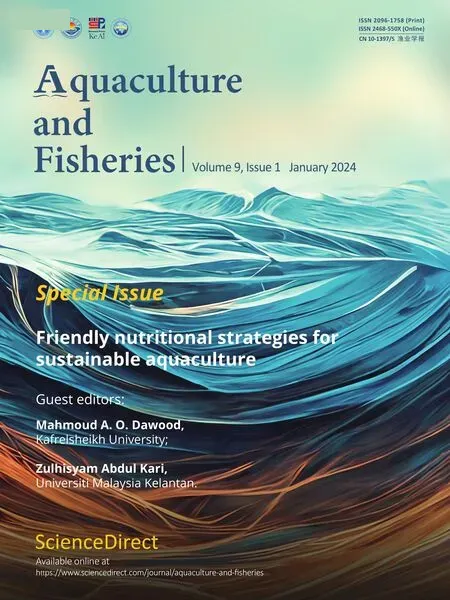Marine yeast Rhodotorula paludigena VA 242 a pigment enhancing feed additive for the Ornamental Fish Koi Carp
R.Rekha,K.A.Nimsi,K.Manjusha,T.K.Sirajudheen
Faculty of Ocean Science &Technology,Kerala University of Fisheries and Ocean Studies (KUFOS), Cochin,Kerala,682506,India
Keywords: Marine yeasts Carotenoids Ornamental fishes Pigment enhancer Feed additive Rhodotorula sp
ABSTRACT Skin colour is an important criterion in determining the aesthetic appeal of ornamental fishes,and thus their market worth.Hence the pigment enhancement in ornamental fishes has been the subject of extensive research by using various synthetic as well as natural pigment sources.Dietary composition is one of the most important elements that influence the development of pigmentation in fish.This study is an attempt to assess the possibility of using carotenogenic marine yeast as pigment enhancer in fish diet for Koi carp,Cyprinus carpio.The 60 days feeding experiment was done by using feed incorporated with mangrove associated marine yeast Rhodotorula paludigena VA242.Greater pigmentation in the scales of fishes fed with experimental feed was observed than that fed with the control diet (normal pellet feed).Furthermore the improved growth rate and general wellbeing in fishes fed with experimental feed provides scope for further studies in this field with respect to the growth and survival of fishes.
1.Introduction
Ornamental fishes come in a wide range of colours and patterns,and the brilliant colour of the fishes is crucial to its success in the ornamental fish sector (Yilmiz &Ergun,2011).The animal’s ability to display colour variations is due to alterations in pigment dispersion.Specialized cells called chromatophores located in the dermis of fishes are responsible for their colouration (Price et al.,2008) and their response to numerous stimuli.Different types of chromatophores in fishes are Melanophore(black colour),Xanthophore (Yellow/orange),Erythrophore (Red),Cyanophore (Blue),Blue iridophores (Blue),Silver iridophores(Silver)and White iridophores (White) (Wucherer &Michiels,2012).Skin colouration is an important attribute in ornamental fishes which enhances the appeal,value and demand especially in ornamental fish business(Saxena,1994;Ebeneezar et al.,2020).There are many factors which affect the colouration of fish.Ornamental fish’s colour gradually fade when kept in the clear waters of aquaria due to captive stress and if dietary carotenoids are lacking (Saxena,1994).
Carotenoid pigments,which are lipid soluble,yellow,red,purple and orange in colour (Mukherjee et al.,2009) are vital nutrients for healthy growth,metabolism,and reproduction.Carotenoids have been proven to play important roles in animal health as precursors of vitamin A,scavengers of active oxygen,and enhancers of in vitro antibody production (Zhao et al.,2019).Several factors such as fish species and its physiological status,water quality and dietary level,quality or feed consumption affect the level of carotenoids in fish tissues (Gupta et al.,2007).As fish are incapable of synthesizing carotenoids in their body(Mukherjee et al.,2009) they are depend on their diet for the same to attain or enhance the skin colouration of the body.
Several researchers have looked into the effects of synthetic carotenoids on skin colouration (Meyers,1994;Buttle et al.,2001;Bowen et al.,2002;Booth et al.,2004;Gouveia et al.,2003;Kop &Durmaz,2008;Yasir &Qin,2010).Shellfishes are also employed as possible carotenoid source (Wilkie,1972;Simpson &Haard,1985).Although,synthetic carotenoids and pigments are commercially available as colour enhancing feed additives,their usage is limited due to high cost and poor uptake levels,consumer awareness about safety and environmental impacts.It has been reported that pigments from Spirulina (Kiriratnikom et al.,2005),Red yeast,Xanthophyllomyces dendrorhous(Xu et al.,2006),Alfalfa,Medicago sativa(Yanar et al.,2008) marigold,Tageteserecta(Vanegas-Espinoza et al.,2011) paprika (Yilmaz et al.,2013) etc.are prospective natural sources of carotenoids in fish(Sathyaruban et al.,2021).Carotenoids can also be produced by numerous microorganisms such as filamentous fungi,yeasts,bacteria and algae (Mussagy et al.,2019).Among these microbes yeast has been identified as the most suitable candidate for carotenoid production because of its fast growth rate and the ease of cultivation.Carotenoid-producing yeasts are mainly represented by the generaRhodotorulasp.,Rhodosporidiumsp.,Sporobolomycessp.,andXanthophylomycessp.(Mannazzu et al.,2015).The advantages of microbial carotenoids over the ones extracted from plants in terms of quality and quantity is that,they are not dependent on the season and raw materials(Valduga etal.,2014).
The enhancement of skin colour by incorporating pigments in the diet is becoming popular in ornamental fish trade these days.Introduction of a new natural pigment source such as marine yeast will help reduce the dependence on synthetic pigments and its adverse effects.In this context,this study evaluated the possibility of using carotenogenic marine yeastRhodotorula paludigenaVA 242 as pigment enhancer ingredient in fish diet.
2.Materials &methods
2.1.Marine yeast used
Rhodotorula paludigenaVA242 (Accession No:OK 353781) marine yeast isolated from mangrove islands of Valanthakkad,Kerala,India was used in this study.
The yeast biomass for the study was produced in Yeast Malt(YM)broth (Hoondee et al.,2019).The cells were harvested by centrifugation at 8000 rpm for 10 min at 4?C.
2.2.Experimental fish feed preparation
Locally purchased formulated pellet feed (1 mm size) was used as control feed.Experimental feed was prepared by incorporating the carotenogenic marine yeastR.paludigenaVA242 into the locally purchased pellet feed.Experimental feed with the following composition 100g (10% of feed) of steam cooked tapioca powder,50g of marine yeast(5%),1000g of powered commercial pellet feed was made into a dough,pelletized,dried for 24 h at 40?C.
2.3.The ornamental fish of choice
The ornamental fishCyprinus carpio,was selected for this study.Healthy animals with good movement and varying pigmentation were procured from a local pet shop and transported in to the lab in polythene bag.For assessing pigmentation,fishes with Orange (Fig.1A) and Dark(Fig.1B) coloured scales were selected.

Fig.1.Koi Carp Fishes selected for the experiment.
2.4.Experimental design and feeding trial
The experimental set up consisted of two fibre glass tanks of 40 L capacity with a common continuous aeration facility.The control and experimental tanks were exposed to the same environmental conditions.Five fishes were maintained in each replicate.The ambient water temperature was 23?C throughout the study period.The period of experiment was 60 days.The animals in control and experimental tanks were fed with locally purchased pellet feed and experimental feed respectively.All the animals were fed twice a day at 10:00 and 16:00 h at the rate of 4% of their body weight.The faecal matter and unconsumed feed were siphoned out daily.Regular water exchange was done and the parameters like temperature,turbidity and feed intake were monitored.
2.5.Parameters studied
Total length,body weight and colour intensity of each animal in both control as well as experimental tanks were measured initially,finally and at intervals of 10 days.Average values of total length and body weight of all five fishes in each tank were used for data interpretation.General wellbeing was also monitored.
2.6.Skin pigmentation studies
Changes in pigmentation at tissue level were assessed by estimating the final carotenoid contents of scales in both experimental and control feed fed fishes.The carotenoid in the orange and dark coloured scales were extracted with Dimethyl Sulphoxide (DMSO) and acetone as per Lopes et al.(2017).The spectrophotometric scan of extract was taken between 400 and 550 nm.The data was recorded.
The concentration of carotenoids in the scales of fishes were calculated using the equation of Vetter et al.(1971).
Where:C=concentration of carotene,A=absorbance,E=extinction coefficient (for β-carotene,E=1.25 × 104μg/L) and L=thickness of cuvettes (path length)1 cm.
3.Results &discussion
The experimental study using the carotenogenic marine yeastR.paludigenaVA242 incorporated experimental feed revealed promising results of pigment content enhancement in Koi carp,Cyprinus carpio.At the same time improvement in growth performance of test animals when compared to control was also noted.Detailed results of the 60 days experiment are given below.
3.1.Growth performance
The average initial total length and body weight of experimental diet fed fishes (Test fish) were 5.73 cm and 3.83g respectively whereas that of fishes in control tanks were 5.6 cm and 3.33g respectively.The final total length and body weight of experimental feed fed Koi carp fishes were 6.87 cm (Fig.2) and 7.23 g (Fig.3) respectively with a difference of 1.14 cm in total length and 3.4g in body weight from initial values.The total length and body weight gained by control group fish were 1.1 cm and 3.27g respectively.This shows an improved growth performance in experimental diet fed fishes with an increase of 0.04 cm in total length and 0.13 g in body weight than the fishes fed with control diet.

Fig.2.Comparison of Increase in length.

Fig.3.Comparison of Weight gain.
The rate of increase in total length and body weight were almost same in both experimental diet fed group and control diet fed fishes during initial face of the study.Improvements in rate of change in total length (Fig.1) and body weight (Fig.2) in experimental diet fed fishes were noted from the 40thday onwards.This proves that the experimental feed incorporated with marine yeastR.paludigenaVA 242 did not negatively affect the growth performance of fishes;in fact,it had improved the growth performance of fishes.All the fishes in both experimental and control tanks were healthy in appearance throughout the study.Regular feed intake and defecation were observed an all the fishes.No signs of diseases,stress or mortality were reported till the end of the experiment.The overall general wellbeing showed promising results in the case of animals fed with experimental diet.
3.2.Pigmentation
The spectrophotometric analysis of the carotenoid content of the scales of the test and control Koi carp revealed that the fishes fed with experimental diet containing caroteinogenic marine yeastR.paludigenaVA242 had greater pigmentation in their scales.Out of two different coloured scales (orange and dark) tested,carotenoid extract of orange scales of experimental diet fed fishes showed maximum absorbance value of 0.0909 while that of control fishes showed an absorbance of 0.0640 in the wavelength range 450–490 nm (Fig.4) indicating higher carotenoid content in fishes fed with experimental diet.The extract of the dark coloured scales of experimental diet fed fishes showed maximum absorbance value of 0.1 nm at wave length of 450 nm,whereas that of the control fed fishes showed a peak value of 0.0801 nm at 460 nm (Fig.5).

Fig.4.UV visible absorption spectra of carotenoid in orange coloured scales of Experimental diet fed fishes and Control diet fed fishes.

Fig.5.UV visible absorption spectra of carotenoid in dark coloured scales of Experimental diet fed fishes and Control diet fed fishes.
The carotenoid concentrations in scales of experimental diet fed fishes were7.27 × 10-6μg/g and 8.00 × 10-6μg/g in the orange and dark coloured scales respectively (Table 1).The carotenoid concentrations in scales of control diet fed fishes showed a lesser values of 5.12 ×10-6μg/g and 6.40 × 10-6μg/g in orange and dark coloured scales respectively.From these observations it is clear that the experimental feed incorporated with marine yeastR.paludigenaVA242 has helped in enhancing (p<0.05) the colour of the scales of experimental diet fed Koi Carp fishes.

Table 1 Comparison of carotenoid pigment concentrations in scales of fishes.
3.3.Discussion
The 60-days experiment examined the use of carotenogenic marine yeastR.paludigenaVA242 as a pigment enhancer ingredient in fish diet to improve the colour of Koi Carp and also examined other factors such as growth performance and general wellbeing of test animals.The result showed an enhancement in the pigmentation of the scales of experimental group when compared to the control group fed with normal pellet feed.The present study proved that use of experimental feed incorporated with carotenogenic marine yeastR.paludigenaVA242 acted as dietary pigment as well as growth enhancer.This is in agreement to the reports of Gouveia et al.(2003) and Jain and Kaur (2016).However,Kurnia et al.(2019) who found that the carotenoid pigments though enhanced pigmentation did not have any effect on the growth performance of the fishes.
Globally there have been several reports on the enhancement of colour by feeding dietary carotenoid supplement from various sources such as fresh water algal biomass (Gouveia et al.,2003),china rose petals (Hibiscus rosasinensis) (Sinh and Asimi,2007),rose petal (Jain &Kaur,2016),red dragon fruit peel meal (Kurnia et al.,2019),synthetic pigments,photosynthetic bacterium andSpirulina platensis(Sun et al.,2012),but none on the use of marine yeast as colour enhancer in fishes.Hence this study is novel.
4.Conclusions
The improved growth rate in Koi Carps fed with carotenogenic marine yeastR.paludigena VA242provides scope for further studies in this field with respect to the growth and survival of fishes.Furthermore,the effect of carotenogenic marine yeast on the Feed Conversion Ratio(FCR),disease prevention and other biological activities may also be a subject of research.
CRediT authorship contribution statement
R.Rekha:Investigation,Visualization.K.A.Nimsi:Methodology,Writing– original draft,Resources,Writing– review &editing.K.Manjusha:Conceptualization,Formal analysis,Supervision,Resources,Validation,Writing– original draft,Writing– review &editing.T.K.Sirajudheen:Supervision,Data curation,Project administration,Formal analysis,Writing– original draft,Writing– review &editing.
Acknowledgements
The authors thank the Kerala State Council for Science,Technology and Environment (KSCSTE) [Order No 573/2017/KSCSTE DTD October 03,2017] for the financial support.The authors also thank Prof.(Dr.) S.Sureshkumar,Dean,Faculty of Ocean Science &Technology,Kerala University of Fisheries &Ocean Studies (KUFOS) for the facilities provided to carry out the study.
 Aquaculture and Fisheries2024年1期
Aquaculture and Fisheries2024年1期
- Aquaculture and Fisheries的其它文章
- Selected dietary plant-based proteins for growth and health response of Nile tilapia Oreochromis niloticus
- The roles of polysaccharides in tilapia farming: A review
- The effects of mixed prebiotics in aquaculture: A review
- Growth performance,fatty acid profile,gut,and muscle histo-morphology of Malaysian mahseer,Tor tambroides post larvae fed short-term host associated probiotics
- Evaluation of growth performance,feed efficiency and nutrient digestibility of red hybrid tilapia fed dietary inclusion of black soldier fly larvae(Hermetia illucens)
- Effects of dietary astaxanthin enrichment on enhancing the colour and growth of red tilapia,Oreochromis sp.
